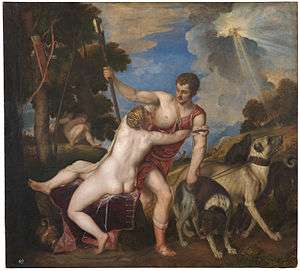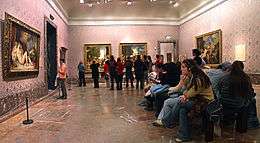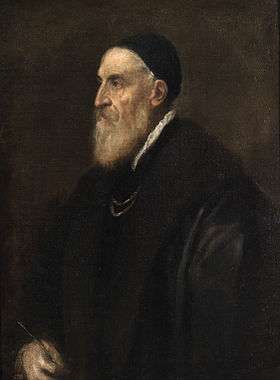Venus and Adonis (Titian, Madrid)
 | |
| Artist | Titian |
|---|---|
| Year | 1554 |
| Medium | Oil on canvas |
| Dimensions | 186 cm × 207 cm (73 in × 81 in) |
| Location | Museo del Prado[1], Madrid |
Venus and Adonis is a subject painted by the Italian late Renaissance artist Titian a number of times. The version now in Madrid's Museo del Prado was executed in Venice in the 1550s. It was part of a series of mythological paintings called "poesie" ("poems") intended for King Philip II of Spain. Venus and Adonis was designed to be viewed alongside Danaë, a painting from the same series with a related composition. It is displayed in the Prado in a room with other Titians including a version of Danaë.
The Prado online catalogue refers to Titian's first version being a painting done in the 1520s, now lost, and describes the painting in the Prado as one of the first to be painted of the "poesie" series.[1] However, the connections between Titian's versions of Venus and Adonis are complicated. The painting commissioned by King Philip II was damaged during delivery, and there is a view that it survives as the so-called Lausanne version, which in 2007 was exhibited for the first time in 200 years at a major scientific exhibition of Titian paintings in Belluno.

It appears that Titian replaced the damaged original with the painting now in the Prado. He went on to paint other versions of the same subject.
The painting is based on the legend of Ovid, though with modifications (Adonis leaves Venus, and not vice versa). It portrays a young Adonis, at dawn, with his dogs, leaving Venus, who desperately tries to keep him with her. The scene symbolizes the force of the hunt call, in turn a metaphor of life and of worldly affairs, which is stronger than that of love (embodied by Cupid, sleeping under trees on the left, arrows helplessly hanging above). In contrast to the later version in Rome, the background features a shining sun emerging from the clouds in an only partially overcast sky.
See also
- Venus and Adonis (Titian, Rome)
- Venus and Adonis by Veronese.
References
- 1 2 "Venus and Adonis". Museo Nacional del Prado. Retrieved 30 October 2015.
Sources
- Gentili, A. (1990). Tiziano (in Italian). Florence.
